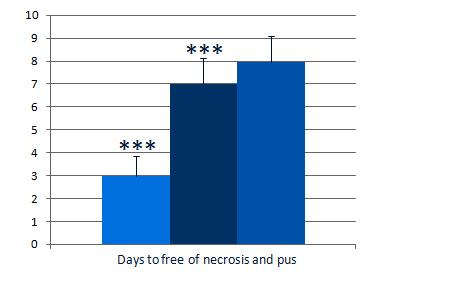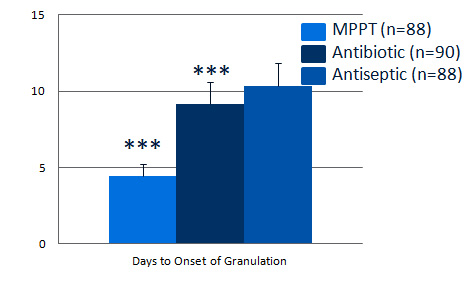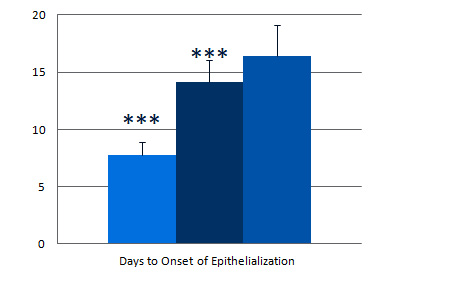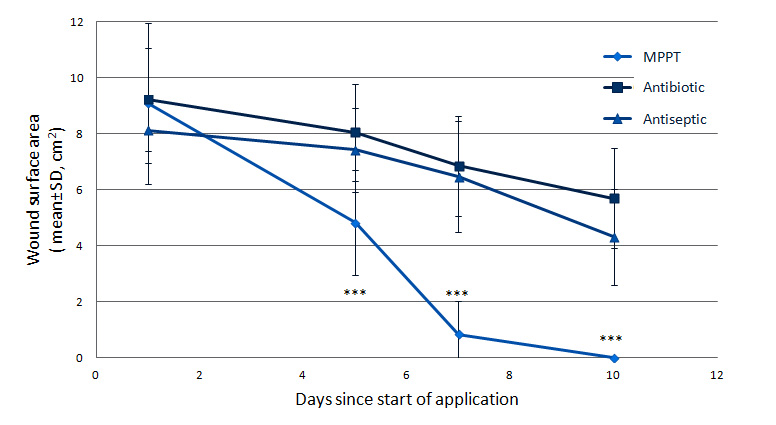See publication in WOUNDS here.
Objective
The purpose of the study was to evaluate the wound healing effects of MPPT and to compare it to antibiotics and antiseptics. The study included a wide range of wounds and ulcers, which were severely colonised to infected. The comparators were a topical antibiotic (gentamicin) and the antiseptic iodine.
Method
- The study included a total of 266 patients with primarily trophic ulcers caused by venous insufficiency of lower extremities and diabetes, carbuncles, phlegmons, infected heat burns of degree III – IV, and infiltrations of postoperative wounds.
- MPPT, a topical antibiotic (gentamicin) and an antiseptic (iodine) were applied once daily to the wound surface and the edges until the wound was clean, i.e. free from necrosis, pus and fibrinogenous thickenings.
- For each patient, it was recorded when the wound reached a clean wound, onset of granulation and onset of epithelialisation as well as the number of bed-days from start of application until the patient was able to leave the hospital to continue treatment at a walk-in clinic.
- For a subgroup of patients with abscesses, carbuncles and post-operative infected wounds, the wound surface area was measured at 4 time points during the first 10 days after start of application.
Results
 |
 |
 |
| Days (mean±SD) to reaching the three Wound Healing Stages in patients following application of MPPT (n=88), antibiotic (n=90), or antiseptic (n=88). | ||
For the entire patient group, the number of days (mean±SD) to reaching a clean wound was 3.0±0.9 for MPPT (n=88) compared to 7.0±1.2 and 8.0±1.1 for antibiotic (n=90) and antiseptic (n=88), respectively. MPPT thus reduced the time to reaching a clean wound by 57% and 62%, respectively. The products were used until reaching a clean wound and days to clean wound therefore also reflect number of days of application. Days to Onset of Granulation were for MPPT, antibiotic, and antiseptic: 4.5±0.8; 9.2±1.4; and 10.3±1.5 days, respectively, and days to Onset of Epithelialisation were: 7.8±1.1; 14.1±1.9; and 16.4±2.7 days, respectively. A sub-group analysis of patients with diabetic foot and venous leg ulcers found that these demonstrated the same pattern of healing.
 The number of hospitalisation-days was 14.6±5.6 for MPPT, 21.0±10.7 for antibiotic and 24.0±7.9 for antiseptic (p<0.001). Compared to the antibiotic, patients receiving MPPT had a 31% reduction in number of hospitalisation-days and compared to the antiseptic 39%. The number of hospitalisation-days was 14.6±5.6 for MPPT, 21.0±10.7 for antibiotic and 24.0±7.9 for antiseptic (p<0.001). Compared to the antibiotic, patients receiving MPPT had a 31% reduction in number of hospitalisation-days and compared to the antiseptic 39%. |
 |
Subgroup of patients with acute wounds.
For the subgroup of patients with carbuncles, abscesses and post-operative infected wounds (n=30 per group) the wound surface area was at Day 1 the same in the three groups, but at Days 5, 7 and 10, the MPPT group had significantly smaller areas than the other groups and reached wound closure significantly faster. There were no significant differences between the antibiotic and the antiseptic.
MPPT did not cause any severe adverse reactions, irritation, bleeding or contact sensitivity.
Discussion
Thomas (2006) found that the critical aspect of the wound healing process for wounds demonstrating delayed healing is to reach the state of a clean wound bed, i.e. free from critical colonisation and inflammation. Once this state has been reached, the healing process will proceed and the time to wound closure is more or less constant.
 |
| Duration of wound healing phases for each of the 3 groups and percent reduction by MPPT compared to a topical antibiotic. |
The present study found that MPPT, compared to a topical antibiotic, reduced the time to a clean wound by 60% and the time from a clean wound to onset of granulation and epithelialisation by 32%. In contrast, the time from onset of epithelialisation to the patient being able to leave the hospital was constant. These data support the theory by Thomas (2006) that reducing the time to a clean wound has a substantial impact on the overall wound healing process, but the data also indicate that the transition from the inflammatory to the proliferative wound healing phase is less distinct and that MPPT also accelerates at least the early stages of the proliferative phase. The study did not follow the individual wounds until closure and the actual duration of the complete proliferative phase is therefore not known, but MPPT reduced the time to onset of epithelialisation by approximately 7 days compared to the antibiotic and the MPPT patients left the hospital 7 days earlier than patients receiving a topical antibiotic, so the data indicate that MPPT mainly achieved its effect by accelerating the transition from the inflammatory phase into the proliferative phase.
Conclusion
MPPT reduced the time to achieving a clean wound by 60% compared to a topical antibiotic (gentamicin) and the antiseptic iodine. Furthermore, MPPT reduced the number of hospitalisation-days by 31% and accelerated the rate of wound closure. Together, these findings demonstrate that MPPT assists the wound healing process and is safe to use.














